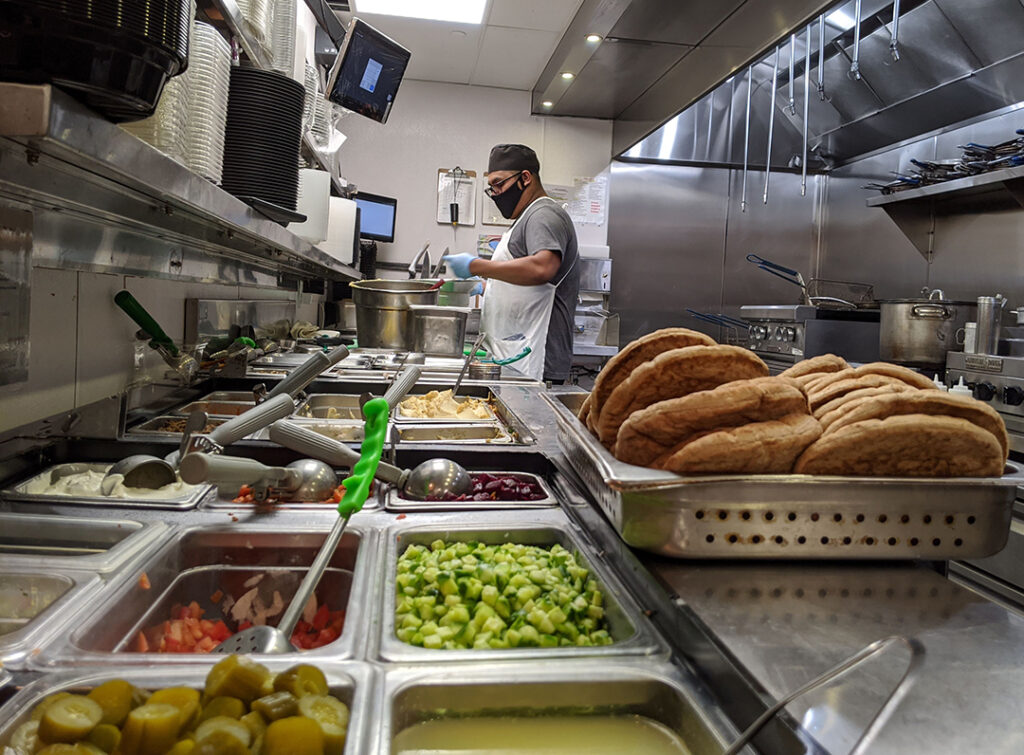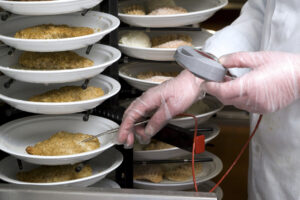[et_pb_section fb_built=”1″ _builder_version=”3.22″][et_pb_row _builder_version=”3.25″ background_size=”initial” background_position=”top_left” background_repeat=”repeat”][et_pb_column type=”4_4″ _builder_version=”3.25″ custom_padding=”|||” custom_padding__hover=”|||”][et_pb_text admin_label=”blog-text” _builder_version=”4.9.9″ custom_margin=”-50px|||” saved_tabs=”all”]
A ghost kitchen can help you support a new territory without leasing a pricey commercial space or large labor costs.
Like on-demand delivery and self-serve kiosks, ghost kitchens are quickly changing the restaurant industry landscape. Ghost kitchens, or virtual kitchens can increase your restaurant’s revenue by extending your restaurant’s offering, simply by working with this new third-party food distribution partner.
These virtual, or ghost kitchens have a license in commercial food production and produce menu items (in partnership with your restaurant) for delivery or take out orders. Like the concept? So do we. Let us show you how to set up and run a ghost kitchen:
Location. Location. Location.
The real estate motto is just as applicable for ghost kitchens, it’s all about the location. And one of the biggest benefits of ghost kitchens is that they can be located virtually anywhere.
A location in a warehouse district with a commercial kitchen will be considerably less than a choice strip mall or retail location with high foot traffic. In fact, you don’t need to be in a high priced strip mall with a lot of foot traffic, you don’t need to pay top dollar for real estate or worry about signage. All you need is kitchen space in a convenient location (for pickup and delivery services) that expands your range.
The Ghost Kitchen Menu
Although your ghost kitchen is saving money on location and FOH employees that you’d be paying for at a physical restaurant, those savings will be offset by delivery costs – whether you handle it in house or through a third-party delivery app. Make sure to include a portion of the delivery costs in your food prices to ensure your kitchen makes a profit.
For your kitchen, your focus should be on prep time, food temperature, taste, and quality. The key here is simplicity, versatility of ingredients, and consistency. The biggest issue you’ll face with food? Time and temperature. Both must be considered when developing your ghost kitchen concept: Offering a limited menu with items that use similar ingredients and preparation methods will keep your food costs low.
Meeting Health & Safety Requirements for Ghost Kitchens
Before you’re operational, your local health department will need to inspect your new location. The health department inspector will review your food storage areas, production methods, and take into account standard operating procedures for food preparation.
The inspector may also want to walk through your menu and know what third-party service providers you plan on using. If you want to make sure your ghost kitchen will pass inspection and be ready for operation, we highly recommend a health department audit to ensure your kitchen is ready.
Staffing a Ghost Kitchen
As an operator, you probably already know, restaurant staffing and retention is already one of your greatest challenges. Fortunately, ghost kitchens don’t require a large staff as the focus is preparing and packaging meals for delivery or take out.
If you intend to offer delivery, you may need to hire drivers. To keep these labor costs low, you should know the ABC’s of hiring, firing and keeping good restaurant employees – effective scheduling is also critical.
Inventory Control for Ghost Kitchens
Properly managing your restaurant inventory helps you prevent waste, lower your food cost, and increase the bottom line. Inventory management is especially important when operating a ghost kitchen. You’ll need to be able to forecast demand based on recent sales data – which can also be a powerful tool to help you manage inventory.
Marketing a Ghost Kitchen
Marketing is a key component to the success of your ghost kitchen. You are going to want to create a plan that pushes your brand to online customers through a variety of platforms. Use social media, maintain your Google My Business and Yelp reviews, and promote “user-generated content” – these are all valuable forms of free advertising. Or hire experts to help you grow and enhance your social media presence.
Using Data to Improve Ghost Kitchen Profits
Once it’s launched and running, you need to be engaged weekly with sales. Use the data you’re collecting through order platforms to determine what is selling, where it is selling, and how often it’s selling.
Keep an eye on online reviews. Pay special attention to comments about delivery speed, food quality and menu items that customers like best. Focus on what’s working and tailor your menu and operations accordingly.
If you follow these steps, you’ll have a ghost kitchen that supports your restaurant operations and takes some of the pressure off your main store – so it can focus on the customer dining experience and selling your brand or concept.
[/et_pb_text][et_pb_text admin_label=”share this – text” _builder_version=”3.27.4″ saved_tabs=”all”]
Share this
[/et_pb_text][et_pb_social_media_follow admin_label=”social media follow – icons” _builder_version=”3.11″ text_orientation=”center” background_layout=”dark” module_alignment=”right” custom_margin=”|||” animation_style=”slide” animation_direction=”top” border_radii=”on|100%|100%|100%|100%”][et_pb_social_media_follow_network social_network=”facebook” url=”https://www.facebook.com/Eyespy/” _builder_version=”3.11″ background_color=”rgba(0,0,0,0.1)” custom_margin=”|10px||10px||true” custom_margin_tablet=”|10px||10px||true” custom_margin_phone=”|10px||10px||true” custom_padding=”10px|10px|10px|10px|true|true” custom_padding_tablet=”10px|10px|10px|10px|true|true” custom_padding_phone=”10px|10px|10px|10px|true|true” follow_button=”off” url_new_window=”on”]facebook
[/et_pb_social_media_follow_network][et_pb_social_media_follow_network social_network=”twitter” url=”https://twitter.com/eyespy_cc/” _builder_version=”3.11″ background_color=”rgba(0,0,0,0.1)” custom_margin=”|10px||10px||true” custom_margin_tablet=”|10px||10px||true” custom_margin_phone=”|10px||10px||true” custom_padding=”10px|10px|10px|10px|true|true” custom_padding_tablet=”10px|10px|10px|10px|true|true” custom_padding_phone=”10px|10px|10px|10px|true|true” follow_button=”off” url_new_window=”on”]twitter
[/et_pb_social_media_follow_network][et_pb_social_media_follow_network social_network=”instagram” url=”https://www.instagram.com/eyespy_cc/” _builder_version=”3.11″ background_color=”rgba(0,0,0,0.1)” custom_margin=”|10px||10px||true” custom_margin_tablet=”|10px||10px||true” custom_margin_phone=”|10px||10px||true” custom_padding=”10px|10px|10px|10px|true|true” custom_padding_tablet=”10px|10px|10px|10px|true|true” custom_padding_phone=”10px|10px|10px|10px|true|true” follow_button=”off” url_new_window=”on”]instagram
[/et_pb_social_media_follow_network][/et_pb_social_media_follow][/et_pb_column][/et_pb_row][/et_pb_section]







